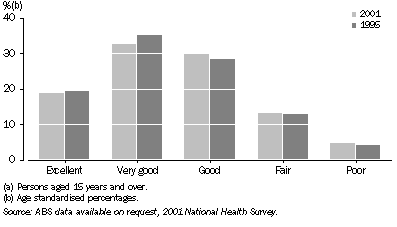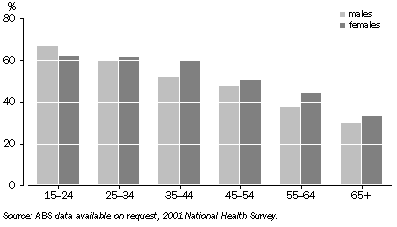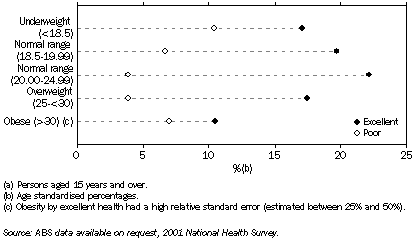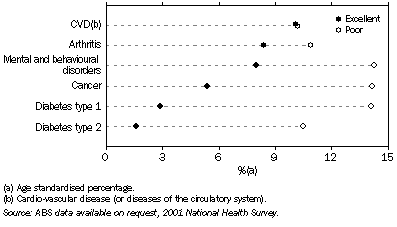NOTES
ABOUT THIS PUBLICATION
This publication presents statistics from the 1995 and 2001 ABS National Health Surveys relating to self-assessed health of those aged 15 years and over. Unless otherwise specified, statistics presented are age standardised. Other data examined include indicators of social capital from the ABS General Social Survey 2002. Behaviour, characteristics and long-term conditions of those who reported good or better health are also analysed.
INQUIRIES
For further information about these and related statistics, contact the National Information and Referral Service on 1300 135 070.
SUMMARY OF RESULTS
INTRODUCTION
This publication considers how people view their own health in relation to other health status indicators and health risk factors. Characteristics such as age and sex, socioeconomic status and education level, health-related behaviour, prevalence of long-term medical conditions, and health-related actions taken are presented. In addition, some indicators of participation in the community are also examined in relation to self-assessed health status.
Self-assessed health as a measure of 'good or better' health
Self-assessed health is a commonly used measure of health status. In the 1995 and 2001 National Health Surveys (NHS) the question used to determine self-assessed health status was, "In general, would you say your health is: Excellent, Very good, Good, Fair or Poor?". This question was originally formulated for the Short Form 36 (SF36) (Ware et al 1993). Although it is a measure of perceived rather than actual health, research has shown that self-assessed health status is a predictor of mortality and morbidity (Gerdtham et al 1999; McCallum et al, 1994).
In the 2001 NHS, the SF1 was asked once on a subsample of respondents who completed the SF36 and once again on the entire sample. Analysis in this publication uses the question asked of the entire sample as this will produce the most reliable estimates (also see Explanatory Note).
While self-assessed health may not always be a measure of a respondent's 'true' health status, it does reveal something about the respondent's perception of their own health at a given point in time. Analysis of self-assessed health status may help understanding about the proportion of people who report good or better health, but also present as being overweight or obese, high risk drinkers, current smokers or having a sedentary lifestyle. Similarly, those who have a serious health complaint but report that their health is good or better may also be of interest.
GENERAL DISTRIBUTION
In the 2001 NHS, those aged 15 years and over who reported good, very good and excellent health were estimated to account for 82% of the population (age standardised). This was similar to those who reported good, very good or excellent health in the 1995 NHS (83%).
The most common category of self-assessed health in both the 1995 and 2001 NHS was very good, followed by good and then excellent. The age standardised proportion of those who reported very good health in 1995 was 35% and in 2001, 33%. In both 1995 and 2001, the age standardised rate of people who reported excellent health was around 19%. The graph below illustrates the distribution of self-assessed health ratings from the 1995 and 2001 NHSs.
Self-assessed health status (a) - 1995 and 2001

The General Social Survey 2002 (GSS) also included the same question on self-assessed health status. Age distribution of self-reported health status was similar between the GSS and the NHS 2001 for very good, fair and poor self-assessed health. However, the General Social Survey showed higher rates of excellent self-reported health and lower rates of good self-reported health. Comparing age standardised rates, the GSS showed that 26% reported excellent health compared to 19% shown in the NHS. Also in the GSS, 25% of respondents reported good health compared to 30% of respondents in the NHS.
Age and sex distribution
After age differences of the population were taken into consideration, females were slightly more likely to report very good or excellent health (53%) than males (50%).
Proportion reporting very good or excellent health, sex - 2001

Across the older age groups, the percentage of very good or excellent self-reported health status was lower than for younger age groups. Conversely, the percentage of people who reported good, fair and poor health was generally higher for older age groups.
CHARACTERISTICS
Index of relative socioeconomic disadvantage
The Index of Relative Socioeconomic Disadvantage is one of the Socioeconomic Indexes for Areas (SEIFA) (see glossary). The index includes attributes such as low income, low educational attainment, high unemployment and jobs in relatively unskilled occupations, and refers to the area in which a person lives, not to the socioeconomic situation of the particular individual. In the 2001 NHS, people living in the most disadvantaged areas tended to be less likely to report very good or excellent health compared to those living in less disadvantaged areas. A similar pattern was observed from results of the General Social Survey 2002. For example, comparing age standardised rates in the GSS, 51% of people living in areas with the most disadvantage reported very good or better health compared to 67% living in the least disadvantaged areas. The table below displays the Index of Relative Socioeconomic Disadvantage quintiles and self-assessed health status from the NHS 2001.
Index of relative socioeconomic disadvantage(a), self-assessed health status(b) - 2001(c) |
|  |
 | Excellent | Very good | Good | Fair | Poor |  |
| Index of relative socioeconomic disadvantage | % | % | % | % | % |  |
|  |
| 1st quintile (most disadvantaged) | 14.2 | 29.1 | 31.4 | 17.6 | 7.7 |  |
| 2nd quintile | 16.5 | 30.7 | 32.3 | 15.2 | 5.4 |  |
| 3rd quintile | 18.4 | 34.0 | 30.4 | 12.9 | 4.2 |  |
| 4th quintile | 20.7 | 33.9 | 29.8 | 11.8 | 3.8 |  |
| 5th quintile (least disadvantaged) | 22.7 | 35.6 | 28.2 | 10.2 | 3.3 |  |
| Total | 18.9 | 32.8 | 30.3 | 13.3 | 4.7 |  |
|  |
| (a) See Glossary. |
| (b) Persons aged 15 years and over. |
| (c) Age standardised percentages. |
Education
In the 2001 NHS, information on highest level of educational attainment was collected for persons aged 18 years or more. Those who had completed a post school qualification were more likely to report excellent health (age standardised rate of 18%) than those who had no post school qualification (14%). In contrast, those who had no post school qualification were more likely to report poor health (5.7%) than those who had finished a post school qualification (3.9%).
Labour force
For persons aged 15 years and over and after adjusting for the different age structures of the population, those who were employed were more likely to report excellent (21%) or very good health (36%) compared to unemployed people (17% reported excellent and 24% reported very good health) and those not in the labour force (15% reported excellent and 26% reported very good health). Women not in the labour force were more likely to report very good health (30%) compared to men who were not in the labour force (for whom 23% reported very good health). Similar rates of self-assessed good health were reported among employed persons, unemployed persons and persons not in the labour force.
SOCIAL CAPITAL
Social capital is a term that relates to the resources available within communities in networks of mutual support. Higher social capital is believed to have beneficial outcomes in many aspects of life including health status (ABS:2004). The ABS General Social Survey (GSS) contained an item on self-assessed health status, as well as various items which measure aspects of social capital such as participation in the community.
Participation in the community
Those who took part in a social activity were more likely to report excellent health than those who did not. For example, of those who took part in social activities, 27% of the population (aged standardised) reported excellent health, compared to 16% (age standardised) of those who did not take part in any of the activities listed in the survey (see table footnote for list of activities included in the survey).
Participation in social activities in the previous three months(a), self-assessed health status - 2002(b) |
|  |
 | Self-assessed health status
|  |
 | Excellent | Poor |  |
| Activity type | % | % |  |
|  |
| Total who participated in social activities(c) | 26.9 | 3.7 |  |
| None of these activities | 15.6 | 10.8 |  |
| Total | 26.1 | 4.4 |  |
|  |
| (a) Persons aged 15 years and over. |
| (b) Age standardised percentages. |
| (c) Social activities include recreational or cultural group activities; community or special interest group activities; church or religious activities; going out to a restaurant or bar; taking part in or attending/watching sport/physical activities; visiting a library, museum or art gallery; attending the movies, theatre or concert; or visiting park/gardens, zoo or theme park. |
BEHAVIOUR OF PEOPLE REPORTING GOOD OR BETTER HEALTH
The behaviours (particularly in relation to risk factors) of those with good or better self-assessed health provide some information about the relationship between perceived health and risk factors. These lifestyle factors as well as the health related actions of those reporting good or better health are included below.
Body mass index (BMI)
In the 2001 NHS, persons in the normal weight range (body mass index of 18.5 to less than 25) were more likely to report excellent health compared to those who were overweight (BMI of 25 to less than 30) and obese (BMI of 30 and over). After age differences were taken into consideration, around 18% of people whose reported height and weight was categorised as overweight and 10% of people who were categorised as obese also reported having excellent health.
Body mass index(a), self-assessed health status - 2001

Alcohol risk level
Adults who drank at high risk levels reported lower rates of very good or better health status (40%) than those who drank at risky (48%) and low risk levels (49%). Those who did not consume alcohol or consumed alcohol but not in the previous week also reported a lower rate of very good or better health than those at low risk and risky alcohol consumption levels. While it may appear from these results that those who drink at risky levels have better self-reported health status than those who do not consume alcohol, caution should be taken when interpreting the result as respondents may have chosen not to drink alcohol due to existing poor health.
Smoking status
In the 2001 NHS, adults who had never smoked and ex-smokers were more likely to report excellent health (19% and 17% respectively) than current smokers (12%). Ex-smokers and those who had never smoked were also more likely to report very good health when compared to current smokers. For example, 29% of ex-smokers, 31% of those who had never smoked and 26% of current smokers reported very good health.
Exercise
The 2001 NHS showed that those who exercised to a high level were most likely to report excellent health (40%) when compared to those who exercised at lower levels or did not exercise. For example, persons who exercised at high levels were 1.7 times more likely to report excellent health than people who exercised at a moderate level. People who reported being sedentary in the two weeks prior to interview were least likely to report excellent (14%) and very good (28%) health.
LONG-TERM CONDITIONS
Long-term conditions are associated with health status, but the nature of the association varies widely depending on the condition. In the 2001 NHS, 87% of those aged 15 years and over reported having a long-term health condition. Of persons who reported a long-term condition, 81% reported either excellent, very good or good health compared to 89% of those who reported no long-term conditions.
Selected National Health Priority Area Conditions
Certain long-term conditions appear to be associated with lower reporting of excellent self-assessed health. Compared to other National Health Priority Area Conditions, in 2001, those aged 15 years and over who had either cancer, or type 1 or type 2 diabetes were less likely to report their health status as excellent.
National Health Priority Areas - 2001

ACTIONS TAKEN
Persons who took none of the specified health related actions (in the two weeks prior to interview) were more likely to report good or better health (89% age standardised) than those who had taken an action for their own health (74% age standardised). In this context, health-related actions may provide some indication of the severity of the reported condition. For example, people with more severe conditions may be more likely to take a health-related action (such as visiting a doctor or an outpatients' clinic) than those whose conditions are less severe.
CONCLUSION
In summary, most of the population aged 15 and over reported good or better health (82%). Females were slightly more likely to report very good or excellent health than males, and younger people tended to report better health compared to older age groups.
People who reported high or moderate levels of exercise were most likely to report excellent and very good health, and current and ex-smokers were the least likely to report good or better health. People with a body mass index within the normal range were more likely to report excellent and very good health than those who were underweight or overweight. Of interest however, a substantial proportion of people who were overweight or obese, current smokers and high risk drinkers also reported that they had excellent health.
Those who lived in areas with the least economic disadvantage, those who were more educated, and employed and who had regular social contact reported the highest self-assessed health.
 Print Page
Print Page
 Print All
Print All